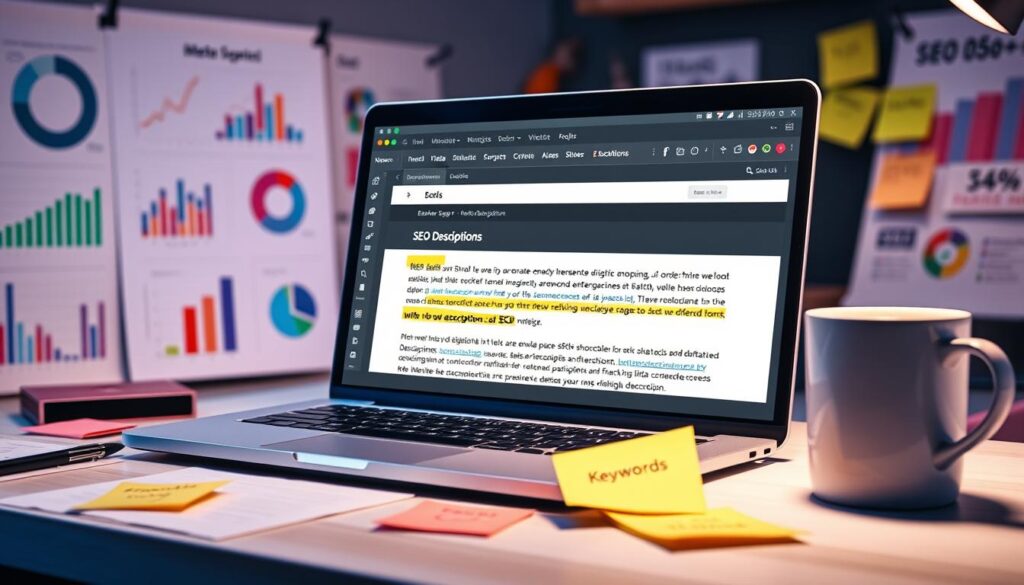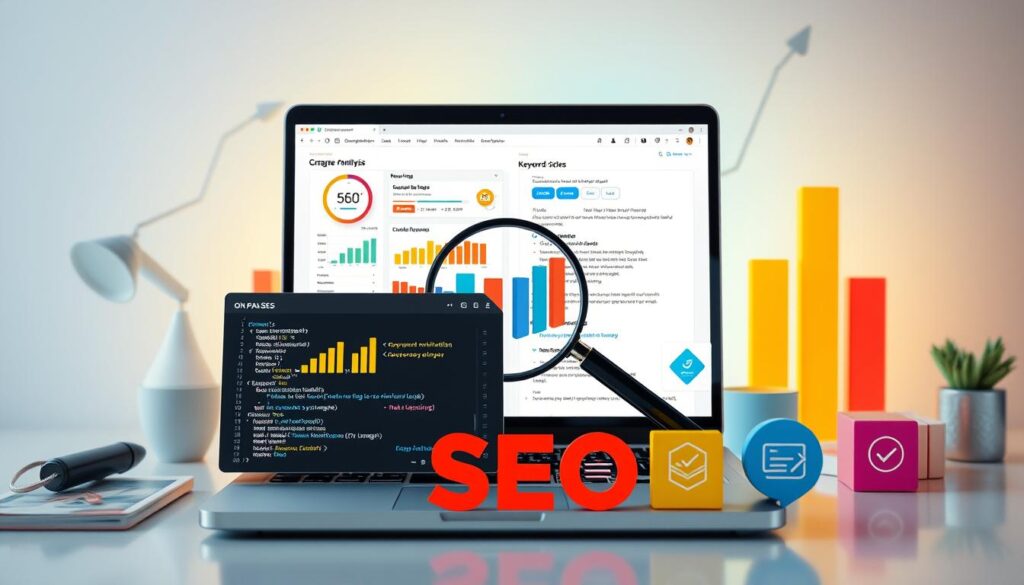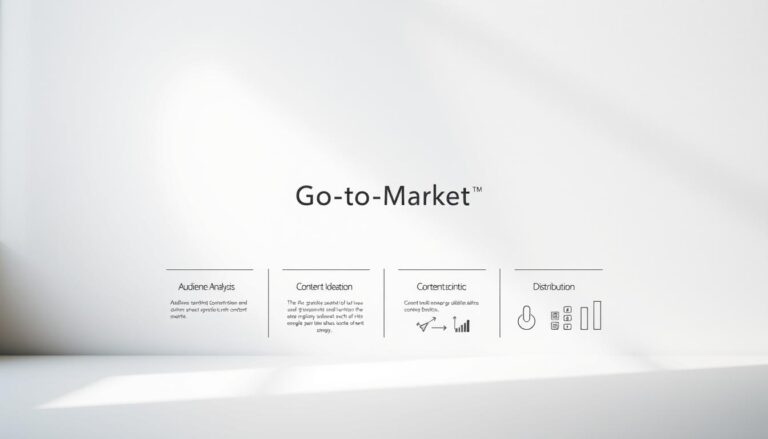On-page SEO helps make your site more visible online. To start, you’ll need a detailed SEO audit. This checks many factors that influence how your site performs in searches. Today, website SEO is essential for creating a strong online presence.
Boost your site’s search rankings with careful on-page optimization. This meets SEO best practices and anticipates what search engines and users expect. Top-ranking pages do more than just show up; they reflect a brand’s reliability and its dedication to meeting user needs precisely.
Key Takeaways
- Improving on-page elements is crucial for helping search engines understand and properly place your web pages.
- Think about SEO more deeply, combining it with user experience and content relevance for the best outcomes.
- Effective on-page SEO does more than improve rankings—it also enhances user experience and the perception of your brand.
- Using thorough SEO strategies improves your website’s structure and prepares it for further SEO work.
- Addressing 13 key on-page SEO factors can greatly improve search engine rankings.
Understanding On-Page SEO
On-page SEO is key for improving your website’s visibility and performance. It combines elements that tell search engines about your site’s content and structure. This ensures your website is indexed and ranked well. On-page SEO not only increases visibility but also enhances user engagement and conversion rates. It does this by lining up your content with what your audience is looking for and their search habits.
Definition and Importance
On-page SEO is about optimizing elements on your site’s pages to improve search rankings. It makes your website easier for search engines like Google to read and better for users to understand. A thorough SEO audit can show how well a page is optimized. It also points out what needs work, like meta tags optimization and content quality.
Key Components of On-Page SEO
Effective on-page SEO includes several important parts. Each part helps improve your site’s ranking and user experience. These parts cover keyword use, content relevance and structure, and meta tags optimization. Following SEO best practices means creating clear URLs, using heading tags correctly, and optimizing images. This doesn’t just help with rankings; it also makes your content clearer and more context-driven for your audience.
The table below lists the key on-page SEO elements and their impact:
| SEO Elements | Description | Impact |
|---|---|---|
| Title Tags | Should be 50-60 characters to optimize visibility in search engine results. | Increases click-through rates by clarifying topic relevance. |
| Meta Descriptions | Brief summaries of the webpage content, ideally under 160 characters. | Enhances user engagement by providing a clear, succinct page summary. |
| Header Tags (H1, H2, H3) | Used to structure content and highlight important sections of your text. | Improves on-page SEO by organizing content and aiding both user and search engine comprehension. |
| Internal Links | Links that connect different pages of the same website, contributing to website SEO architecture. | Enhances navigation and increases time on site, whilst helping search engines crawl the site more effectively. |
| Mobile Responsiveness | Ensures that web pages perform well on all devices. | Addresses the significant share of mobile users, impacting overall site accessibility and usability. |
Efficiently integrating these SEO elements can lead to more traffic and better engagement. Besides technical improvements, there’s a growing focus on content quality and value. This leads to higher conversion and retention rates. Thus, boosting content quality and perfecting on-page SEO boosts both strategies. This paves the way for lasting online success.
Keyword Research and Placement
Effective keyword research and strategic placement are key to nailing SEO best practices. They boost your site’s visibility in searches. Finding and placing the right optimize on-page SEO factors makes content more relevant. Let’s look at how to pick great keywords and where to put them in your content.
Identifying Valuable Keywords
To start keyword research, know your audience and the market. You can use tools to find keywords with high monthly searches. These keywords should match what users are looking for. For example, “paranormal investigators” might bring in more focused visitors than very broad terms. The goal is to find keywords that are relevant and have a good search volume.
Best Practices for Keyword Placement
After finding the best keywords, it’s crucial to place them smartly in your content. It’s not just about adding keywords anywhere. For top SEO best practices, put them in titles, headings, and the beginning of your content. This helps with better visibility.
- Title Tags and Meta Descriptions: Use main keywords in title tags and meta descriptions to improve clicks and meta tags optimization.
- Headers: Put keywords in headers to organize content and help search engines grasp your content’s theme.
- Alt Text for Images: Add keywords in image alt text for better SEO and to make images more relevant.
- Content Body: Spread keywords naturally in your content. Avoid overusing them to prevent penalties and improve content optimization.
Mastering keyword research and placement takes your content to the top of search results. It boosts engagement and traffic. Always use these strategies with SEO best practices in mind to make the most of your online presence.
Crafting Compelling Title Tags
Having excellent on-page optimization boosts site visibility and user interest. Title tags are key for SEO wins. They help both SEO writing and digital marketing strategies.
Importance of Title Tags for SEO
Title tags matter a lot for SEO audit tactics. They affect click rates and rankings. These headlines are your content’s first impression in search results. Their charm and relevance matter. For better title tags, RankScience suggests using strategic keywords and keeping them short.
Tips for Writing Effective Titles
For top meta tags optimization, focus on concise structure and main keywords. This caters directly to what users are searching for. Titles should be 50 to 60 characters to avoid being cut off in search displays. This ensures your full message reaches the audience.
| SEO Element | Importance | Best Practice |
|---|---|---|
| Title Tag Length | Prevents truncation in SERPs | 50-60 characters |
| Keyword Inclusion | Improves visibility and SEO ranking | Use primary keyword near the beginning |
| Yearly Updates | Maintains relevancy | Include current year in title tags |
| Engaging Modifiers | Increases CTR | Use numbers, dates, and call-to-actions |
Use real-time analytics, like Google Search Console, to tweak title tags. This improves search relevance and pulls in more users. Testing and optimizing tags boosts click rates and SEO rankings.
Optimized title tags, when combined with on-page optimization, lift your online visibility and SEO success. Paying close attention to these details sets a standout digital marketing strategy apart from basic efforts.
Developing SEO-Friendly Meta Descriptions
Meta descriptions are key to getting more clicks from search results. By getting better at optimizing meta tags, you can make your website more visible and attractive in search outcomes.
Purpose of Meta Descriptions
Meta descriptions give a brief overview of web pages, helping in SEO. They convince people to click on your website, boosting visits. Though they don’t directly impact rankings, great meta descriptions improve user interaction.
Character Count and Optimization Tips
For best SEO, keep meta descriptions under 155 characters to avoid cuts. Make sure to include the main keyword to match searches and up the page’s relevance.
To make your meta descriptions better, they should be unique for each page. Avoid using the same descriptions across your site. It could harm how search engines see your content. Write descriptions that are clear and highlight what benefits the reader, matching their interests.

| Factor | Impact on SEO | Best Practice |
|---|---|---|
| Unique Content | Improves indexing and relevancy | Create specific descriptions for each page |
| Keyword Inclusion | Enhances visibility for targeted queries | Incorporate primary keywords sensibly |
| Character Length | Prevents truncation in search results | Keep under 155 characters |
| Engaging Copy | Increases click-through rates | Use active voice and action-oriented language |
| Relevance to Page Content | Ensures consistency and user satisfaction | Match description closely to page content |
Following these tips will help you optimize your meta descriptions. This improves how users see your site and its ranking in searches.
Utilizing Header Tags Effectively
In the world of on-page SEO, using header tags right can really help organize content and make it more visible to search engines. Knowing how H1, H2, and H3 tags differ is key for SEO writing. Each one plays a specific role in structuring content and setting up a hierarchy.
Difference Between H1, H2, and H3 Tags
Header tags like H1 to H3 are key for arranging content clearly. The H1 tag is for the main page title. It shows what the page is about and uses the main keyword to help with SEO. Then, H2 tags break the main topic into smaller chunks. They make the content easier to read and use secondary keywords for better SEO.
Lastly, H3 tags go into more detail under each H2 section. This makes the content even better for SEO.
Best Practices for Header Tag Usage
Following the best practices for header tags can improve a page’s SEO and make it nicer for users. It’s best to use just one H1 per page to keep things clear. Also, using multiple H2 and H3 tags can help organize content well. This makes it easier for both people and search engines to get through the story and find important details.
Adding short content pieces right after header tags can also help your content show up in featured snippets. This makes your content more visible.
For SaaS companies, tools like YOAST SEO, SEMRUSH, and AHREFS are great for keeping an eye on and tweaking header tag use.
| Header Tag | Importance | Usage Recommendations |
|---|---|---|
| H1 | Most important; sets topic theme | One per page, include main keyword |
| H2 | High importance; main subtopics | Multiple per page, use secondary keywords |
| H3 | Detail content sections | Use under respective H2s to divide content into sub-sections |
Keeping a consistent style and format across all header tags is good for on-page SEO and makes content easier to read. Don’t use too many headers. Make sure each one has a clear purpose. This guides readers through your content effectively.
Enhancing Content Quality and Relevance
To win in the race of search engine rankings, improving content quality and relevance is key. Content that’s engaging, thoroughly researched, and expertly written matches well with what users are looking for. It also matches Google’s ranking algorithms focus on E-E-A-T (Experience, Expertise, Authoritativeness, and Trustworthiness).
Importance of Quality Content for SEO
Content quality goes beyond just being informative. It must also be very relevant to what users are searching for. As Google’s algorithms get smarter, they favor content that deeply understands its topics. This is crucial since 93% of users don’t go past the first page of search results. Content that is seen as authoritative and trustworthy boosts website SEO. This leads to better visibility and more user engagement.
Strategies for Content Optimization
Using SEO best practices can really boost on-page SEO. It makes your content perform better and appear more valuable. Below are some top strategies to use:
- Keyword Integration: Do in-depth keyword research. Make sure your content meets the specific searches that a lot of people are making.
- Multimedia Use: Add relevant pictures with the right alt texts and videos. This makes your content more diverse and engaging. It helps users understand your message more easily.
- Structured Data: Use schema markup so search engines understand and show your content better, increasing visibility.
- Internal Linking: Smartly link to other pieces of your content. This improves how people navigate your site and how they find information.
- Continuous Updates: Keep your content up-to-date and accurate. This helps it stay relevant over time.
- UI/UX Optimization: Make sure your web pages respond quickly and don’t take long to load. This makes visiting your site a better experience for users.
Putting these strategies into action needs ongoing effort. You need to keep up with changing SEO standards and user habits.
| SEO Factor | Implementation Strategy | Expected Impact |
|---|---|---|
| Keyword-rich URLs | Use short, descriptive URLs that reflect page content | Improves relevance and ease of indexing |
| Quality Backlinks | Collaborate with authoritative sites to gain natural backlinks | Boosts site authority and trustworthiness |
| Readability & Engagement | Ensure content is well-structured, using headings and lists for clarity | Increases user time on page and satisfaction |
| Meta Information | Optimize title tags and meta descriptions to reflect search intent | Enhances click-through rates and search presence |
| E-E-A-T Principles | Regularly update content to uphold expertise and accuracy | Strengthens content reliability and depth |

Improving Page Load Speed and Responsiveness
In today’s digital world, a good website SEO relies heavily on improving site performance. Page load speed is crucial for Google and other search engines. It affects both rankings and user retention. Important factors like server response time, which should be under 200 milliseconds, and optimizing images and files are key for a website’s smooth function.
Factors Affecting Page Load Speed
Several technical aspects can slow down website SEO. Issues like slow time to first byte, large content sizes, and delayed user interactions are crucial. Websites with big files, too many redirects, or unoptimized code suffer from long load times. This can increase bounce rates. In fact, a delay of just one second can increase bounce rates by up to 32%, harming user experience and possible sales.
Tools to Measure and Improve Speed
There are effective tools to help improve mobile optimization and overall website speed. Google PageSpeed Insights, Semrush Site Audit, and Pingdom Website Speed Test provide valuable feedback. For Shopify users, GemPages helps by converting images to the more efficient WebP format. Regular SEO audits and following the Core Web Vitals help in making sites faster. This includes enabling compression, minifying code, using browser caching, and employing content delivery networks to enhance site performance. Reducing load time from 1 to 5 seconds significantly cuts the risk of losing 90% of traffic, showing that fast speed is essential online.
FAQ
What is on-page SEO and why is it important?
On-page SEO makes web pages rank higher and get more relevant traffic from search engines. It involves improving content, HTML tags, and website structure. It’s key for making search engines understand a page’s content and how it relates to searches, which helps improve rankings.
What factors are involved in an SEO audit for on-page optimization?
An SEO audit looks at title tags, meta descriptions, content quality, URL structure, and user experience. It also checks site speed and internal linking. The aim is to find ways to boost the website’s SEO performance.
How do you conduct keyword research for your website’s SEO?
Keyword research uses tools to find what users are searching for that’s related to your content. This step helps pinpoint keywords with lots of searches, relevance to your audience, and manageable competition.
What are some SEO best practices for keyword placement on a webpage?
Best practices include using the main keyword in title tags, meta descriptions, and headings like H1. Sprinkle keywords throughout the content and in image alt texts. This keeps the content readable and natural.
What role do title tags play in on-page SEO?
Title tags are vital for on-page SEO, guiding search engines on a webpage’s topic and relevance. They show up in search results as clickable headlines. Optimizing the title tag can boost rankings and click-through rates.
How can I write effective title tags to improve my website’s SEO?
To craft effective title tags, keep them short, include your keyword, and match the page’s content. Avoid keyword stuffing. Make each title unique and stay under 60 characters for best display in search results.
What are meta descriptions and how do they affect SEO?
Meta descriptions are short summaries of webpages that appear in search results. Good meta descriptions increase click-through rates, indirectly boosting SEO by driving more site traffic.
How long should a meta description be, and what are the best practices for writing one?
A meta description should be 150-160 characters to fit in search results. Include your main keyword, summarize the content clearly, and use a call to action to encourage clicks.
What is the difference between H1, H2, and H3 tags in HTML?
H1 tags are for the main titles and should be used once per page for the primary topic. H2 tags are for secondary titles, and H3s are for tertiary. They help organize content and show its importance on a page.
How should header tags be used for optimal SEO?
Use header tags to order content clearly. Put target keywords in at least the H1 tag. Use H2 and H3 for easier reading and not too many headers. They should create a clear content hierarchy.
Why is quality content important for SEO?
Quality content matters for SEO as it engages users, encourages sharing, and earns backlinks. It helps websites rank better by meeting search engines’ needs for relevant, authoritative content.
What strategies can be employed to optimize content for on-page SEO?
To optimize on-page SEO, create engaging, quality content. Use keywords well and make content easy to read. Add both internal and external links, update content often, and include images and videos to engage users more.
What factors influence the page load speed of a website?
Things like server time, large files, unoptimized images, many HTTP requests, and JavaScript can slow down a page. It’s crucial to keep these in check to speed up loading, which benefits the user experience and SEO.
Which tools can be used to measure and improve a website’s page load speed?
Google PageSpeed Insights, GTmetrix, and Pingdom help measure and boost a site’s loading time. They offer tips for improvements like compressing pictures, reducing code, using browser caching, and optimizing server times.



